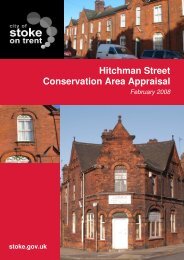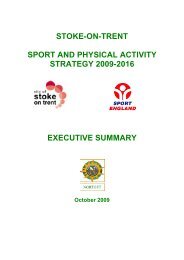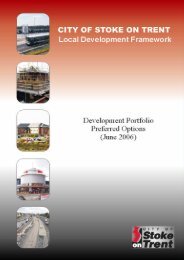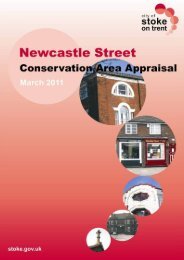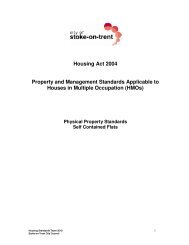Director of Public Health Annual Report 2012 [pdf] - Stoke-on-Trent ...
Director of Public Health Annual Report 2012 [pdf] - Stoke-on-Trent ...
Director of Public Health Annual Report 2012 [pdf] - Stoke-on-Trent ...
Create successful ePaper yourself
Turn your PDF publications into a flip-book with our unique Google optimized e-Paper software.
Currently, three out <str<strong>on</strong>g>of</str<strong>on</strong>g> five people aged over 60 in England suffer from a l<strong>on</strong>g-term c<strong>on</strong>diti<strong>on</strong> 6<br />
and as the populati<strong>on</strong> c<strong>on</strong>tinues to age these<br />
numbers are predicted to increase. Having a 85% <str<strong>on</strong>g>of</str<strong>on</strong>g> deaths in the UK are from<br />
l<strong>on</strong>g-term c<strong>on</strong>diti<strong>on</strong> is not just about ageing, in<br />
l<strong>on</strong>g-term c<strong>on</strong>diti<strong>on</strong>s<br />
England 4.3 milli<strong>on</strong> people under the age <str<strong>on</strong>g>of</str<strong>on</strong>g> 40<br />
have a l<strong>on</strong>g-term c<strong>on</strong>diti<strong>on</strong>.<br />
It is estimated that 85% <str<strong>on</strong>g>of</str<strong>on</strong>g> deaths in the UK are from LTCs. Within this, 36% <str<strong>on</strong>g>of</str<strong>on</strong>g> all deaths will<br />
be from a l<strong>on</strong>g-term cardiovascular disease and 7% from a l<strong>on</strong>g-term respiratory disease.<br />
Comm<strong>on</strong> mental health problems affect about <strong>on</strong>e in seven <str<strong>on</strong>g>of</str<strong>on</strong>g> the adult populati<strong>on</strong> whilst<br />
severe mental health problems affect <strong>on</strong>e in a hundred.<br />
People with LTCs can experience poorer clinical outcomes, l<strong>on</strong>ger hospital stays, and the<br />
average cost <str<strong>on</strong>g>of</str<strong>on</strong>g> health and care for some<strong>on</strong>e with LTCs is much higher than those without<br />
as illustrated in figure 10. L<strong>on</strong>g-term c<strong>on</strong>diti<strong>on</strong>s are not just a health issue, they can have a<br />
significant impact <strong>on</strong> a pers<strong>on</strong>’s ability to work and live life to the full as well as <strong>on</strong> carers and<br />
other members <str<strong>on</strong>g>of</str<strong>on</strong>g> their family.<br />
L<strong>on</strong>g-term c<strong>on</strong>diti<strong>on</strong>s have an impact <strong>on</strong> the individual and the ec<strong>on</strong>omy. A Labour Force<br />
survey c<strong>on</strong>ducted in 2009 found that 50% <str<strong>on</strong>g>of</str<strong>on</strong>g> people with a LTC found it a barrier to the<br />
amount <str<strong>on</strong>g>of</str<strong>on</strong>g> work they could do. The survey also found that this increased to 80% for<br />
individuals with three or more LTCs 7 . People with physical LTCs are up to 3 to 4 times more<br />
likely to experience depressi<strong>on</strong> and anxiety disorders. People with at least <strong>on</strong>e LTC are<br />
about 10% less likely to be in employment than people with n<strong>on</strong>e 8 .<br />
The 2001 census asked people “Do you have any l<strong>on</strong>g-term illness, health problem or<br />
disability which limits your daily activities or the work you can do" Almost 1 in 4 (23%) <str<strong>on</strong>g>of</str<strong>on</strong>g><br />
resp<strong>on</strong>dents from <str<strong>on</strong>g>Stoke</str<strong>on</strong>g>-<strong>on</strong>-<strong>Trent</strong> reported that they did have a c<strong>on</strong>diti<strong>on</strong> that limited their<br />
abilities, and three out <str<strong>on</strong>g>of</str<strong>on</strong>g> five (60%) were from the under 65 age group. We are still waiting<br />
for the full data from the 2011 census to be reported but it is expected that the findings will<br />
be broadly similar.<br />
This has an impact <strong>on</strong> healthy life expectancy (HLE), which is an estimate <str<strong>on</strong>g>of</str<strong>on</strong>g> how l<strong>on</strong>g an<br />
individual could expect to live their life in good health. With advances in modern medicine,<br />
technology and modern society, people are living l<strong>on</strong>ger, but increasing age has not always<br />
g<strong>on</strong>e hand in hand with an increase in the number <str<strong>on</strong>g>of</str<strong>on</strong>g> healthy years that people can expect to<br />
live. Across <str<strong>on</strong>g>Stoke</str<strong>on</strong>g>-<strong>on</strong>-<strong>Trent</strong>, both males and females are expected to have more time lived in<br />
ill or poor health compared to males and females in England. Data based <strong>on</strong> the previous<br />
ward boundaries (pre-2011 wards) indicate HLE ranged from 58.7 years to 71.0 years for<br />
males in <str<strong>on</strong>g>Stoke</str<strong>on</strong>g>-<strong>on</strong>-<strong>Trent</strong>. There was a similar gradient for females ranging from 62.5 years to<br />
73.2 years 9 . This means that, as the current male life expectancy in <str<strong>on</strong>g>Stoke</str<strong>on</strong>g>-<strong>on</strong>-<strong>Trent</strong> is 76.2,<br />
men could experience between 5.2 and 17.5 years <str<strong>on</strong>g>of</str<strong>on</strong>g> poor health. Similarly for women, as<br />
current female life expectancy is 80.2 years, they could experience between 7.0 and 17.7<br />
years <str<strong>on</strong>g>of</str<strong>on</strong>g> poor health.<br />
37 | P a g e


![Director of Public Health Annual Report 2012 [pdf] - Stoke-on-Trent ...](https://img.yumpu.com/32721490/39/500x640/director-of-public-health-annual-report-2012-pdf-stoke-on-trent-.jpg)





